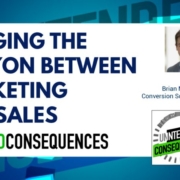Positioning Your Product or Service
Positioning your product or service requires understanding the root desire of your website visitors. This changes from visitor to visitor. Positioning your offering generically to appeal to them all doesn’t work. Find out what does.
Why do people buy robot vacuums?
Is it to clean the floor? Maybe.
Is it to have more leisure time? Maybe.
Is it to be seen as tech-savvy to your friends? Hmmm.
Is it to see how your cat will react? That’s interesting.
These are the kinds of questions that the “Jobs to be Done” framework seeks to tease out. Your website and your marketing should address one or more of these positioning statements — at least the valid ones.
“So, Jobs to be Done is a framework that is used to understand the crux of what your customer or potential customer is looking for, to understand what is driving them in the moment where they are ready to make a purchase.”
How do businesses like Casper and Warby Parker carve out space in competitive markets? By positioning the product to a market desire that isn’t obvious to the market leaders.
“Casper was brilliant in convincing people with perfectly fine mattresses that they needed to receive a mattress by mail.”
This is what me and Tara Hunt, my guest on this episode of Intended Consequences discuss. We also talk about the Flywheel approach.
Positioning your product or service accurately is one step. The next is to get into the minds of your audience. Casper used podcasts as one salient way to reach their audience.
“Casper was on podcasts and people that listen to podcasts tend to think companies that advertise on podcasts are cool.”
How to Manage Positioning Your Product or Service
If you’re like me, the positioning ideas are crowding around in your head right now. Old ideas that you thought were just too risky to try are vying for attention against new ideas from my conversation with Tara.
It’s time to give your intuition a little help.
When you get back to the office, immediately open up a clean spreadsheet. Label the first column “Idea”. Label the second column “Data”.
Start jotting the thoughts in your head in the first column. Just describe them enough so that you can recall them in detail later. If you need to draw something, reference the page in your journal in the Idea column.
The “Data” column is where you will list ways to test the idea. List any and all of these that apply:
- Similar campaigns that have succeeded
- A report in analytics that you should run to get evidence
- A strategy for trying the idea in the marketplace safely
- Surveys, focus groups, or user testing that could vet the idea
- Any allies that may have supporting evidence for the idea
This is the beginning of your hypothesis list, a list that should guide your curiosity as you write, design, plan and create communications.
Get in the habit of opening it when you start a new design, document or project.
Now go science something.
Links and Resources
Connect with Tara on Linkedin
Learn more about Truly.
Cluetrain Manifesto
Donna Pappacosta “Earbud Intimate”
Jim Collins Flywheel
Know Your Customers’ “Jobs to Be Done”
Imagineering Story Trailer
Follow Brian on LinkedIn
- How to Compare Data When You Move from Google Analytics to GA4 - April 7, 2023
- CRO and SEO Working Together with Jason Fisher - November 17, 2022
- Why Web Design for Conversion Needs Science - May 4, 2022
















I liked the part about creating demand where none exists by having marketing that is so good.
Thank you.
Thanks for reading!
Great podcast! Here’s what I liked: examples, new information (I never heard of “jobs to be done”), new worldview of looking at our client’s problems and the journey of their customers.
Thanks for the kind words and the feedback, Michele.